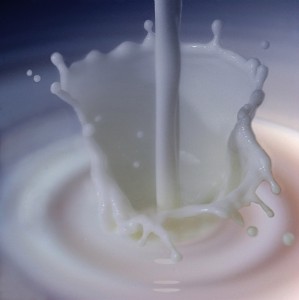Baby it’s cold outside
Most of the Earth’s surface is colder than the inside of your refrigerator. Deep sea temperatures are almost universally 2-4C. That’s already 73% of the Earth’s surface. Then add to that the polar regions, mountain ranges and permafrost and you have about 85% of the Earth’s surface constantly at refrigerator or freezer temperatures. While there are many microbes adapted to life at those temperatures, microbiology has historically been dealing with mesophiles (“middle [temperature] loving”) that with psychrophiles (“cold lovers”). This is mostly for historical and practical reasons: medical microbiology has always been dominant and our body temperature is 37C. Another historic branch of the development of microbiology was the food industry, and most processes in that branch take place at temperatures between 10 and 40 C. Indeed we pasteurize milk at 60C, and then store it at 4C to stave off curdling by bacteria.
Anyone who failed to empty their milk carton on time knows that some microbes do eat (and therefore grow) at near-zero temperatures. Nevertheless, we don’t know about cold bacteria, even though as we have seen, most of the real estate on Earth is cold. Also, if we were to find life in the solar system, it would probably be found on the cold moons of Jupiter and Saturn, in the Martian ice caps, or in subsurface Martian ice. The first step to understand how life might exist there, is to understand how it exists in the cold here.
If you leave a carton of milk outside on a hot day, it will spoil within hours. Left in the refrigerator, it will take a week or two. The optimal operating temperature for most milk spoiling bacteria is about 35C: they evolved to colonize mammary glands, and the spores of opportunistic microbes that are general consumers of proteins and sugars are those that we generally find around in the warmer climes. Placed in the refrigerator, some of them will simply not do anything. Some will continue to live, but eat slower: hence the large time gap in curdling.
But life at <5C can also thrive, not just survive. Some bacteria function at <5C at the same metabolic rate as the 35C life we are familiar with. Those kind of microbes live in more than one extreme: they are found in the lower layers of the ocean, where the water pressure is high, oxygen is scarce and nutrients are few. Most psychrophiles have to contend with more than cold-stress: cold environments go hand in hand with high salinity, high radiation (top of mountains), conversely darkness (polar nights),low nutrients, high pressure (deep ocean), low oxygen concentration…
When we go to subzero temperatures, things get really interesting. James Tiedje’s group in Michigan State University studied gene expression in a Exiguobactererim sibiricum, which, as it’s name suggests, is spending its life in rather cold climes. Actually, the permafrost from which it was isolated has been frozen for the past 3,000,000 years. They looked at it which genes it makes at different temperatures, including -2.5C.
Bacteria that are viable at subfreezing temperatures are way cool, pun intended. For one thing, the water in their cells does not freeze: their solute levels are high, but apparently no higher than other bacteria. The water shell immediately enveloping them is liquid, even though the ground they live in has been frozen for thousands years. RNA tends to get stickier at low temperatures: it forms helices & loops, getting all tangly, and cannot be easily undone and read. Psychrophiles invest energy in producing cold shock proteins that untangle the RNA, smoothing it out and making it legible. In subfreezing temperature, they also make the cell wall thicker: this probably protects them from the surrounding ice. E. sibiricum stops making flagella, which makes sense since moving in a mostly solid is an exercise in futility. E. sibiricum also has special versions of some of its enzymes that work better in cold temperatures.
For enzymes to work better in lower temperature, there is some tradeoff between functionality and stability. Subzero versions of enzymes seem to be more flexible, but their catalytic ability is worse. But at least they work in cold temperatures, unlike their mid-temperature homologs. Metpally and Reddy from Queen’s College, CUNY have compared the sequences of all known psychrophilic enzymes to their mesophilic homologs. They found interesting differences in the amino acid composition. The cold version of the enzymes tend to be flexible to the point of being floppy: apparently they don’t freeze up as well as their temperate-clime loving counterpart.
Another reason to study psychrophiles is evolutionary. One interesting hypothesis about Earth’s history is the Snowball Earth hypothesis. Snowball Earth claims that Earth was nearly or completely frozen 850 to 635 Mya. According to this hypothesis, Earth’s surface and oceans were almost completely frozen, with the possible exception of hot pockets of geothermal activity. It may therefore be that certain psychrophiles represent very ancient bacterial or archaeal clades.
If this post has left you unsatisfied and wanting to know more about how bacteria can live in the cold, well, join the queue. We don’t know a lot about psychrophilic bacteria. They are hard to culture, isolate and study, and they are relative newcomers to microbiology. There is a lot to do in this field of bacteria who come in from the cold.
And what about the title? Well, I chose the rather gaudy and campy version of Tom Jones & Cerys Matthews for this song. So bad, it’s good.
Debora F Rodrigues, Natalia Ivanova, Zhili He, Marianne Huebner, Jizhong Zhou, James M Tiedje (2008). Architecture of thermal adaptation in an Exiguobacterium sibiricum strain isolated from 3 million year old permafrost: A genome and transcriptome approach BMC Genomics, 9 (1) DOI: 10.1186/1471-2164-9-547
Raghu Metpally, Boojala Reddy (2009). Comparative proteome analysis of psychrophilic versus mesophilic bacterial species: Insights into the molecular basis of cold adaptation of proteins BMC Genomics, 10 (1) DOI: 10.1186/1471-2164-10-11
P. W. Bergholz, C. Bakermans, J. M. Tiedje (2009). Psychrobacter arcticus 273-4 Uses Resource Efficiency and Molecular Motion Adaptations for Subzero Temperature Growth Journal of Bacteriology DOI: 10.1128/JB.01377-08
Georges Feller, Charles Gerday (2003). Psychrophilic enzymes: hot topics in cold adaptation Nature Reviews Microbiology, 1 (3), 200-208 DOI: 10.1038/nrmicro773






















Well done! Seems very accessible for the lay reader. Relative to “It may therefore be that certain psychrophiles represent very ancient bacterial or archaeal clades” – have none of these species had their genomes sequenced yet, to place them in relation to others using genetic taxonomy?
@Alethea a few have, mainly eubacteria, as opposed to archea. Frankly, I don’t know much about comparative genomics of psychrophiles vs. mesophiles so I cannot really answer your question.
Can you add the credits to the Mont Blanc picture ?
Thanks